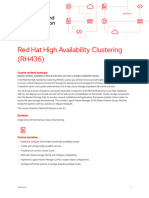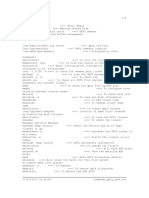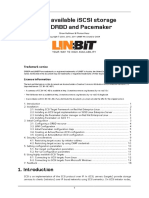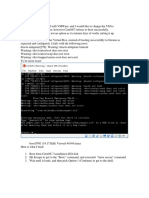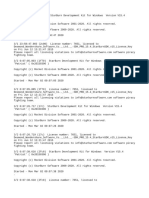Exercise #1A: Install and Configure A GPFS Cluster: Objectives: Requirements
Uploaded by
Hepeng DuitExercise #1A: Install and Configure A GPFS Cluster: Objectives: Requirements
Uploaded by
Hepeng DuitExercise #1A: Install and configure a GPFS cluster
Objectives:
Use the GPFS web based administration tool to install a GPFS cluster
Requirements:
Node names and IP address provided by instructor Node1:________________________ Node2:________________________ Account/Cluster name used for exercise Name: root Password: __________________ ClusterName: _______________
Step 1: Initialize the Lab Environment
This lab assumes the rpm packages have already been installed on the servers. The packages for linux are: gpfs.base-3.2.1-0.i386.rpm gpfs.docs-3.2.1-0.noarch.rpm gpfs.gui-3.2.1-0.i386.rpm gpfs.src-3.2.1-0.noarch.rpm gpfs.base-3.2.1-0.i386.update.rpm gpfs.gpl-3.2.1-0.noarch.rpm gpfs.msg.en_US-3.2.1-0.noarch.rpm You can install the packages manually by copying them to each node and running rpm or the GPFS install wizard will distribute the packages for you. You need to manually install the packages on at least one node and start the GUI by running: /etc/init.d/gpfsgui start
Step 2: Create the GPFS cluster
In this step you will create a GPFS cluster on two nodes using the GPFS web based administration interface. 1. Open a web browser to the GPFS
http://\[node1 ip address\]/ibm/console Account: root Password:
2. Login using the account and password provided by the instructor.
3.
4. In the navigation pane select "GPFS Management" then "Install GPFS". This will start the GPFS configuration wizard.
5. Select "Create a new Session". This will take you to the Define hosts page. 6. Under "Defined hosts" click "Add" 1. Enter the name or ipaddress of node1, and the root password. 2. Select "Add this host and add the next host."
7. Close the Task process dialogue when completed.
8. Enter the IP address and root password for node2 and select "Add host." Close the Task process dialogue when completed.
9. The hosts have now been added. Select next to go to the Install and Verify Packages page. On this page select "Check existing package installation." Close the task dialog when the check is complete. 10. GPFS Ships an open source component called the GPL layer that allows the support of a wide variety of Linux kernels. The GPL layer installation page checks that the GPL layer is built and installed correctly. If it is not, the installer will complete the build and install. Select "Check existing GPL layer installation". Close the "Task" dialog when the check is complete. 11. GPFS verifies the network configuration of all nodes in the cluster. Select "Check current settings" to verify the network configuration. Close the "Task" dialog when the check is complete. 12. GPFS uses ssh (Or other remote command tool) for some cluster operations. The installer will verify that ssh is configured properly for a GPFS cluster. Select "Check Current Settings" to verify the ssh config. Close the "Task" dialog when the check is complete. 13. It is recommended, though not required, that all the servers synchronize the time using a protocol such as NTP. For this lab we will skip the NTP setup. Choose "Skip Setup" to continue. 14. Next, you set the name the GPFS cluster. Enter the cluster name and select " Next." 15. The last step is to define the primary and secondary cluster configuration servers. Since this is a two node cluster we will leave it at the defaults. Select "Next" to continue. 16. Select Next to complete the cluster configuration. Close the "Task" dialog when the configuration is complete. 17. When you select "Finish" you will be directed to the cluster management page.
18. The GPFS cluster is now installed and running.
Exercise #1B: Install and configure a GPFS cluster
Objectives
Verify the system environment Create a GPFS cluster Define NSD's Create a GPFS file system An AIX 5.3 System o Very similar to linux config with rpm instead of AIX binary images and Linux admin commands are different At least 4 hdisks GPFS 3.3 Software with latest PTF Verify nodes properly installed 1. Check that the oslevel is supported On the system run oslevel Check the GPFS FAQ:http://publib.boulder.ibm.com/infocenter/clresctr/vxrx/index.jsp__ 2. Is the installed OS level supported by GPFS? Yes No 3. Is there a specific GPFS patch level required for the installed OS? Yes No 4. If so what patch level is required? ___________ Verify nodes configured properly on the network(s) 1. Write the name of Node1: ____________ 2. Write the name of Node2: ____________ 3. From node 1 ping node 2 4. From node 2 ping node 1 If the pings fail, resolve the issue before continuing. Verify node-to-node ssh communications (For this lab you will use ssh and scp for communications) 1. On each node create an ssh-key. To do this use the command ssh-keygen; if you don't specify a blank passphrase, -N, then you need to press enter each time you are promoted to create a key with no passphrase until you are returned to a prompt. The result should look something like this:
# ssh-keygen -t rsa -N "" -f $HOME/.ssh/id_rsa Generating public/private rsa key pair. Created directory '/.ssh'. Your identification has been saved in /.ssh/id_rsa. Your public key has been saved in /.ssh/id_rsa.pub. The key fingerprint is: 7d:06:95:45:9d:7b:7a:6c:64:48:70:2d:cb:78:ed:61 sas@perf3-c2-aix
You will need
1.
Step 1: Verify Environment
2.
3.
2. 3. 4. 5.
On node1 copy the /.ssh/id_rsa.pub file to /.ssh/authorized_keys
cp /.ssh/id_rsa.pub /.ssh/authorized_keys
From node1 copy the /.ssh/id_rsa.pub file from node2 to /tmp/id_rsa.pub
scp node2:/.ssh/id_rsa.pub /tmp/id_rsa.pub
Add the public key from node2 to the authorized_keys file on node1
cat /tmp/id_rsa.pub >> /.ssh/authorized_keys
Copy the authorized key file from node1 to node2
scp /.ssh/authorized_keys node2:/.ssh/authorized_keys
6.
To test your ssh configuration ssh as root from node 1 to node1 and node1 to node2 until you are no longer prompted for a password or for addition to the known_hosts file. node1# ssh node1 date node1# ssh node2 date node2# ssh node1 date node2# ssh node2 date Supress ssh banners by creating a .hushlogin file in the root home directory
touch /.hushlogin
7. 4.
Verify the disks are available to the system For this lab you should have 4 disks available for use hdiskn-hdiskt. 1. Use lspv to verify the disks exist 2. Ensure you see 4 disks besides hdisk0 talk.
Step 2: Install the GPFS software
On node1
1. 2. 3. 4. 5. 6. 7. Locate the GPFS software in /yourdir/software/base/
cd /yourdir/software/base/
Run the inutoc command to create the table of contents
inutoc .
Install the base GPFS code using the installp command
installp -aXY -d/yourDir/software/basegpfs -f all
Locate the latest GPFS patch level in /yourdir/software/PTF/
cd /yourdir/software/PTF/
Run the inutoc command to create the table of contents
inutoc .
Install the PTF GPFS code using the installp command
installp -aXY -d/yourdir/software/PTFgpfs -f all
Repeat Steps 1-7 on node28.
lslpp -L gpfs.\*
On node1 and node2 confirm GPFS is installed using lslpp
the output should look similar to this
# lslpp -L gpfs.\* Fileset Level State Type Description (Uninstaller) ---------------------------------------------------------------------------gpfs.base 3.3.0.3 A F GPFS File Manager gpfs.docs.data 3.3.0.3 A F GPFS Server Manpages and Documentation gpfs.gui 3.3.0.3 C F GPFS GUI gpfs.msg.en_US 3.3.0.1 A F GPFS Server Messages U.S. English
8.
Note: Exact versions of GPFS may vary from this example, the important part is that all three packages are present. Confirm the GPFS binaries are in your path using the mmlscluster command
# mmlscluster mmlscluster: 6027-1382 This node does not belong to a GPFS cluster. mmlscluster: 6027-1639 Command failed. Examine previous error messages to determine cause.
Note: The path to the GPFS binaries is: /usr/lpp/mmfs/bin
Step 3: Create the GPFS cluster
For this exercise the cluster is initially created with a single node. When creating the cluster make node1 the
primary configuration server and give node1 the designations quorum and manager. Use ssh and scp as the remote shell and remote file copy commands. *Primary Configuration server (node1): __ ______ *Verify fully qualified path to ssh and scp: ssh path___ _____ scp path_____________
1. 2. Use the mmcrcluster command to create the cluster
mmcrcluster -N _node01_:manager-quorum -p _node01_ -r /usr/bin/ssh -R /usr/bin/scp
Run the mmlscluster command again to see that the cluster was created
# mmlscluster GPFS cluster information ======================== GPFS cluster name: node1.ibm.com GPFS cluster id: 13882390374179224464 GPFS UID domain: node1.ibm.com Remote shell command: /usr/bin/ssh Remote file copy command: /usr/bin/scp GPFS cluster configuration servers: ----------------------------------Primary server: node1.ibm.com Secondary server: (none) Node Daemon node name IP address Admin node name Designation ----------------------------------------------------------------------------------------------1 perf3-c2-aix.bvnssg.net 10.0.0.1 node1.ibm.com quorum-manager
3.
Set the license mode for the node using the mmchlicense command. Use a server license for this node.
mmchlicense server --accept -N node01
Step 4: Start GPFS and verify the status of all nodes
1. 2. Start GPFS on all the nodes in the GPFS cluster using the mmstartup command
mmstartup -a
Check the status of the cluster using the mmgetstate command
# mmgetstate -a Node number Node name GPFS state -----------------------------------------1 node1 active
Step 5: Add the second node to the cluster
1. 2. 3. 4. One node 1 use the mmaddnode command to add node2 to the cluster
# mmaddnode -N node2
Confirm the node was added to the cluster using the mmlscluster command
# mmlscluster
Use the mmchcluster command to set node2 as the secondary configuration server
# mmchcluster -s node2
Set the license mode for the node using the mmchlicense command. Use a server license for this node.
mmchlicense server --accept -N node02
5. 6.
Start node2 using the mmstartup command
# mmstartup -N node2
Use the mmgetstate command to verify that both nodes are in the active state
# mmgetstate -a
Step 6: Collect information about the cluster
Now we will take a moment to check a few things about the cluster. Examine the cluster configuration using the mmlscluster command
1. What is the cluster name? ______________________ 2. What is the IP address of node2? _____________________ What date was this version of GPFS "Built"? ________________ Hint: look in the GPFS log file: /var/adm/ras/mmfs.log.latest
Step 7: Create NSDs You will use the 4 hdisks.
Make sure they can all hold data and metadata Leave the storage pool column blank. Leave the Primary and Backup server fields blank Sample input files are in /yourdir/samples On node 1 create directory /yourdir/data Create a disk descriptor file /yourdir/data/diskdesc.txt using the format:
#DiskName:PrimaryServer:BackupServer:DiskUsage:FailureGroup:DesiredName:StoragePool hdiskw:::dataAndMetadata::nsd1: hdiskx:::dataAndMetadata::nsd2: hdisky:::dataAndMetadata::nsd3: hdiskz:::dataAndMetadata::nsd4:
1. 2.
Note: hdisk numbers will vary per system.
3. 4. Create a backup copy of the disk descriptor file /yourdir/data/diskdesc_bak.txt
cp /yourdir/data/diskdesc.txt /yourdir/data/diskdesc_bak.txt
Create the NSD's using the mmcrnsd command
mmcrnsd -F /yourdir/data/diskdesc.txt
Step 8: Collect information about the NSD's
Now collect some information about the NSD's you have created.
1. Examine the NSD configuration using the mmlsnsd command 1. What mmlsnsd flag do you use to see the operating system device (/dev/hdisk?) associated with an NSD? _______
Step 9: Create a file system
Now that there is a GPFS cluster and some NSD's available you can create a file system. In this section we will create a file system. Set the file system blocksize to 64kb
1. 2.
Mount the file system at /gpfs Create the file system using the mmcrfs command
mmcrfs /gpfs fs1 -F diskdesc.txt -B 64k
Verify the file system was created correctly using the mmlsfs command
mmlsfs fs1
Is the file system automatically mounted when GPFS starts? _______________
3. 4. Mount the file system using the _mmmount_ command
mmmount all -a
Verify the file system is mounted using the df command
# df -k Filesystem 1024-blocks Free %Used Iused %Iused Mounted on /dev/hd4 65536 6508 91% 3375 64% / /dev/hd2 1769472 465416 74% 35508 24% /usr /dev/hd9var 131072 75660 43% 620 4% /var /dev/hd3 196608 192864 2% 37 1% /tmp /dev/hd1 65536 65144 1% 13 1% /home /proc - - /proc /dev/hd10opt 327680 47572 86% 7766 41% /opt /dev/fs1 398929107 398929000 1% 1 1% /gpfs
5.
Use the mmdf command to get information on the file system.
mmdf fs1
How many inodes are currently used in the file system? ______________
Exercise #2: Storage Pools, Filesets and Policies
Objectives:
Create storage pools Create a file system Create filesets Implement a Placement Policy Define and execute a file management policy
Requirements:
Complete Exercise 1: Installing the cluster List of available devices /dev/sd__ /dev/sd__ /dev/sd__ /dev/sd__ /dev/sd__
Step 1: Create A File System With 2 Storage Pools
Storage pools are defined when an NSD (Network Shared Disk) is created. You will use the 4 disks (labelled sd_ through sd_ ) provided by your instructor to create 2 storage pools. Since the storage is all direct attached, no NSD servers are needed. Place the disks into two storage pools and make sure both pools can store file data. hints: Create 2 disks per storage pool The first pool must be the system pool. The system pool should be able to store data and metadata Only the system pool can contain metadata # Create a disk descriptor file /gpfs-course/data/pooldesc.txt using the format:#DiskName:serverlist::DiskUsage:FailureGroup:DesiredName:StoragePool
/dev/sd__:::dataAndMetadata::nsd1:system /dev/sd__:::dataAndMetadata::nsd2:system /dev/sd__:::dataOnly::nsd3:pool1 /dev/sd__:::dataOnly::nsd4:pool1
The two storage pools will be system and pool1. 1. Create a backup copy of the disk descriptor file
/gpfs-course/data/pooldesc_bak.txt
2. Create the NSD's using the mmcrnsd command.
> mmcrnsd -F /gpfs-course/data/pooldesc.txt -v no mmcrnsd: Processing disk sdc mmcrnsd: Processing disk sdd mmcrnsd: Processing disk sde mmcrnsd: Processing disk sdf mmcrnsd: Propagating the cluster configuration data to all affected nodes. This is an asynchronous process.
3. Create a file system based on these NSD's using the mmcrfs command * Set the file system blocksize to 64KB * Mount the file system at /gpfs Command: "mmcrfs /gpfs fs1 -F /gpfs-course/data/pooldesc.txt -B 64k -M 2 -R 2" Example:
gpfs1:~ # mmcrfs /gpfs fs1 -F /gpfs-course/data/pooldesc.txt -B 64k -M2 -R2 The following disks of fs1 will be formatted on node gpfs1:
nsd1: size 20971520 KB nsd2: size 20971520 KB nsd3: size 20971520 KB nsd4: size 20971520 KB Formatting file system ... Disks up to size 53 GB can be added to storage pool 'system'. Disks up to size 53 GB can be added to storage pool 'pool1'. Creating Inode File 45 % complete on Wed Sep 26 10:05:27 2007 89 % complete on Wed Sep 26 10:05:32 2007 100 % complete on Wed Sep 26 10:05:33 2007 Creating Allocation Maps Clearing Inode Allocation Map Clearing Block Allocation Map 42 % complete on Wed Sep 26 10:05:52 2007 83 % complete on Wed Sep 26 10:05:57 2007 100 % complete on Wed Sep 26 10:05:59 2007 43 % complete on Wed Sep 26 10:06:04 2007 85 % complete on Wed Sep 26 10:06:09 2007 100 % complete on Wed Sep 26 10:06:10 2007 Completed creation of file system /dev/fs1. mmcrfs: Propagating the cluster configuration data to all affected nodes. This is an asynchronous process.
4. Verify the file system was created correctly using the mmlsfs command
> mmlsfs fs1
5. Mount the file system using the mmmount command
> mmmount fs1 -a
6. Verify the file system is mounted using the df command.
> df Filesystem /dev/sda3 tmpfs /dev/sda1 /dev/fs1 1K-blocks Used Available Use% Mounted on 32908108 10975916 21932192 34% / 2019884 4 2019880 1% /dev/shm 72248 45048 27200 63% /boot 3989291072 491992640 3497298432 13% /gpfs
7. Verify the storage pool configuration using the mmdf command
> mmdf fs1 disk disk size failure holds holds free KB free KB name in KB group metadata data in full blocks in fragments --------------- ------------- -------- -------- ----- -------------------- ------------------Disks in storage pool: system nsd1 102734400 -1 yes yes 102565184 (100%) 90 ( 0%) nsd2 102734400 -1 yes yes 102564608 (100%) 96 ( 0%) -------------------------------- ------------------(pool total) 205468800 205129792 (100%) 186 ( 0%) Disks in storage pool: pool1 nsd3 102734400 nsd4 102734400 ------------(pool total) 205468800 (data) (metadata) (total) ============= 410937600 205468800 ============= 410937600 -1 no -1 no yes 102732288 (100%) yes 102732288 (100%) -------------------- ------------------205464576 (100%) 62 ( 0%) 62 ( 0%) 124 ( 0%)
==================== =================== 410594368 (100%) 310 ( 0%) 205129792 (100%) 186 ( 0%) ==================== =================== 410594368 (100%) 310 ( 0%)
Inode Information ----------------Number of used inodes:
4038
Number of free inodes: 397370 Number of allocated inodes: 401408 Maximum number of inodes: 401408
Step 2: Create Filesets
We are going to 5 filesets to organize the data. 1. Create 5 filesets fileset1-fileset5 using the mmcrfileset command
> > > > > mmcrfileset mmcrfileset mmcrfileset mmcrfileset mmcrfileset fs1 fs1 fs1 fs1 fs1 fileset1 fileset2 fileset3 fileset4 fileset5
2. Verify they were created using the mmlsfileset command
# mmlsfileset fs1
What is the status of fileset1-fileset5? _______________ 3. Link the filesets into the file system using the mmlinkfileset command
# # # # # mmlinkfileset mmlinkfileset mmlinkfileset mmlinkfileset mmlinkfileset fs1 fs1 fs1 fs1 fs1 fileset1 fileset2 fileset3 fileset4 fileset5 -J -J -J -J -J /gpfs/fileset1 /gpfs/fileset2 /gpfs/fileset3 /gpfs/fileset4 /gpfs/fileset5
Now what is the status of fileset1-fileset5? ___________________
Step 3: Create a file placement policy
Now that you have two storage pools and some filesets you need to define placement policies to instruct GPFS where you would like the file data placed. By default, if the system pool can accept data, all files will go to the system storage pool. You are going to change the default and create 3 placement rules. The rules will designate: Data in fileset1 to fileset4 go to the system storage pool Data in fileset5 go to the pool1 storage pool files that end in .dat go to pool1 storage pool 1. Start by creating a policy file /gpfs-course/data/placementpolicy.txt
/* The fileset does not matter, we want all .dat and .DAT files to go to pool1 */ RULE 'datfiles' SET POOL 'pool1' WHERE UPPER(name) like '%.DAT' /* All non *.dat files placed in filset5 will go to pool1 */ RULE 'fs5' SET POOL 'pool1' FOR FILESET ('fileset5') /* Set a default rule that sends all files not meeting the other criteria to the system pool */ RULE 'default' set POOL 'system'
2. Install the new policy file using the mmchpolicy command
> mmchpolicy fs1 placementpolicy.txt
Step 4: Testing the placement policies
Now you will do some experiments to see how policies work. Use this chart to track the experiments results. You can get the amount of free space by using the mmdf command.
1. Record the "Before" free space in the chart 2. Create a file in fileset1 called bigfile1
dd if=/dev/zero of=/gpfs/fileset1/bigfile1 bs=64k count=10000
3. Record the free space in each pool using the mmdf command (Bigfile1)
> mmdf fs1 disk disk size failure holds holds free KB free KB name in KB group metadata data in full blocks in fragments --------------- ------------- -------- -------- ----- -------------------- ------------------Disks in storage pool: system nsd1 20971520 -1 yes yes 20588288 ( 98%) 930 ( 0%) nsd2 20971520 -1 yes yes 20588608 ( 98%) 806 ( 0%) -------------------------------- ------------------(pool total) 41943040 41176896 ( 98%) 1736 ( 0%) Disks in storage pool: pool1 nsd3 20971520 nsd4 20971520 ------------(pool total) 41943040 (data) (metadata) (total) -1 no -1 no yes 20969408 (100%) 62 ( 0%) yes 20969408 (100%) 62 ( 0%) -------------------- ------------------41938816 (100%) 124 ( 0%) ==================== =================== 83115712 ( 99%) 1860 ( 0%) 41176896 ( 98%) 1736 ( 0%) ==================== =================== 83115712 ( 99%) 1860 ( 0%)
============= 83886080 41943040 ============= 83886080
Inode Information ----------------Number of used inodes: Number of free inodes: Number of allocated inodes: Maximum number of inodes:
4044 78132 82176 82176
4. Create a file in fileset1 called bigfile1.dat
dd if=/dev/zero of=/gpfs/fileset1/bigfile1.dat bs=64k count=1000
Record the free space (bigfile1.dat) 5. Create a file in fileset5 called bigfile2
dd if=/dev/zero of=/gpfs/fileset5/bigfile2 bs=64k count=1000
Record the free space (bigfile2) 6. Questions Where did the data go for each file? Bigfile1 ______________ Bigfile1.dat ______________ Bigfile2 ______________ Why?
7. Create a couple more files (These will be used in the next step)
> dd if=/dev/zero of=/gpfs/fileset3/bigfile3 bs=64k count=10000 > dd if=/dev/zero of=/gpfs/fileset4/bigfile4 bs=64k count=10000
Step 5: File Management Policies
Now that you have data in the file system you are going to manage the placement of the file data using file management policies. For this example your business rules say that all file names that start with the letters "big" need to be moved to pool1. In addition, all files that end in ".dat" should be deleted. 1. To begin, create a policy file /gpfs-course/data/managementpolicy.txt that implements the business rules.
RULE 'datfiles' DELETE WHERE UPPER(name) like '%.DAT' RULE 'bigfiles' MIGRATE TO POOL 'pool1' WHERE UPPER(name) like 'BIG%'
2.
Test the rule set using the mmapplypolicy command
> mmapplypolicy fs1 \-P managementpolicy.txt \-I test
This command will show you what mmapplypolicy will do but will not actually perform the delete or migrate.
3.
Actually perform the migration and deletion using the mmapplypolicy command
> mmapplypolicy fs1 \-P managementpolicy.txt
4.
Review: Review the output of the mmapplypolicy command to answer these questions. How many files were deleted? ____________ How many files were moved? ____________ How many KB total were moved? ___________
Step 6: Using External Pools
In this step you will use the external pool interface to generate a report. 1. Create two files : expool1.bash, listrule1.txt: File /tmp/expool1.bash
#!/bin/bash dt=`date +%h%d%y-%H_%M_%S` results=/tmp/FileReport_${dt} echo one $1 if [[ $1 == 'MIGRATE' ]];then echo Filelist echo There are `cat $2 | wc -l` files that match >> ${results} cat $2 >> ${results} echo ---echo - The file list report has been placed in ${results} echo ---fi
File listrule1.txt
RULE EXTERNAL POOL 'externalpoolA' EXEC '/tmp/expool1.bash' RULE 'MigToExt' MIGRATE TO POOL 'externalpoolA' WHERE FILE_SIZE > 2
Note: You may need to modify where clause to get a list of files on your file system. 2. Make the external pool script executable
chmod +x /tmp/expool1.bash
3. Execute the job
mmapplypolicy test1 -P listrule1.txt
It will print output to the screen. When it is done it will print the location of the results file. For example: The file list report has been placed in /tmp/FileReport_Jul3108-20_15_50 4. What information do you see in the file?
Exercise #3: Using Replication
In this lab we will configure a file system for replication.
Objectives:
Requirements:
Enable data and metadata replication Verify and monitor a file's replication status
1. Complete Exercise 1: Installing the cluster 2. List of available devices /dev/sd__ /dev/sd__ /dev/sd__ /dev/sd__
Step 1: Enabling Replication
1. The max replication factor should have been set in Lab 1. Use the mmlsfs command to verify the file system is enabled for replication. A file system is enabled for replication when the maximum number of data and metadata replicas is set to 2. 2. If these parameters are not set to 2 you will need to recreate the file system. To recreate the file system a. Umount the file system b. Delete the file system c. Create the file system and specify -M 2 and -R 2
> mmcrfs /gpfs fs1 \-F pooldesc.txt \-B 64k \-M 2 \-R 2
Where pooldesc.txt is the disk descriptor file from Lab 1
Step 2: Change the failure group on the NSDs
1. View the current failure group settings using the mmdf command
> mmlsdisk fs1
The failure group should be set to a value of -1 2. Change the failure group to 1 for nsd1 and nsd3 and to 2 for nsd2 and nsd4 using the mmchdisk command.
> > > > mmchdisk mmchdisk mmchdisk mmchdisk fs1 fs1 fs1 fs1 change change change change -d -d -d -d "nsd1:::dataAndMetadata:1:::" "nsd2:::dataAndMetadata:2:::" "nsd3:::dataOnly:1:::" "nsd4:::dataOnly:2:::"
3. Verify the changes using the mmdf command
mmlsdisk fs1
Notice that data was not written because the default replication level is still set to 1. Now that there are two failure groups you can see how to change the replication status of a file.
Step 3: Replicate a file
Replication status can bet set at the file level. In this step we will replicate the data and metadata of a single file in the file system. 1. Create a file in the GPFS file system, /gpfs, called bigfile10
dd if=/dev/zero of=/gpfs/fileset1/bigfile10 bs=64k count=1000
2. Use the mmlsattr command to check the replication status of the file bigfile10
> mmlsattr /gpfs/fileset1/bigfile10 replication factors metadata(max) data(max) file [flags] ------------- --------- --------------1 ( 2) 1 ( 2) /gpfs/fileset1/bigfile10
3. Change the file replication status of bigfile10 so that it is replicated in two failure groups using the mmchattr command.
mmchattr \-m 2 \-r 2 /gpfs/fileset1/bigfile10
Notice that this command take a few moments to execute, as you change the replication status of a file the data is copied before the command completes unless you use the "-I defer" option. 4. Again use the mmlsattr command to check the replication status of the file bigfile10
> mmlsattr /gpfs/fileset1/bigfile10
Did you see a change in the replication status of the file?
Step 4: Replicate all data in the file system
If desired you can replicate all of the data in the file system. In this step we will change the default replication status for the whole file system. 1. Create a file in fileset1 called bigfile11
dd if=/dev/zero of=/gpfs/fileset1/bigfile11 bs=64k count=1000
2. Use the mmlsattr command to check the replication status of the file bigfile11
mmlsattr /gpfs/fileset1/bigfile11
3. Using the mmchfs command change the default replicaton status for fs1.
mmchfs fs1 \-m 2 \-r 2
4. Use the mmlsattr command to check the replication status of the file bigfile11
mmlsattr /gpfs/fileset1/bigfile11
Has the replication status of bigfile11 changed? _________________ 5. The replication status of a file does not change until mmrestripefs is run or a new file is created. To test this create a new file called bigfile12
dd if=/dev/zero of=/gpfs/fileset1/bigfile12 bs=64k count=1000
6. Use the mmlsattr command to check the replication status of the file bigfile10
mmlsattr /gpfs/fileset1/bigfile12
Is the file replicated? 7. You can replicate the existing files in the file system using the mmrestripefs command
mmrestripefs fs1 \-R
Exercise #4: Snapshots
Objectives:
In this lab we will use the snapshot feature to create online copies of files. Create a file system snapshot Restore a user deleted file from a snapshot image Manage multiple snapshot images
Requirements:
1. Complete Exercise 1: Installing the cluster 2. A File System - Use Exercise 2 to create a file system if you do not already have one.
Step 1: Use a snapshot to backup a file
A snapshot is a point in time view of a file system. To see how snapshots operate you will create a file, take a snapshot, delete the file then restore the snapshot from the file. 1. Create a file for testing in the /gpfs/fileset1 directory.
echo "hello world:snap1" > /gpfs/fileset1/snapfile1
2. Create a snapshot image using the mmcrsnapshot command
> mmcrsnapshot fs1 snap1 Writing dirty data to disk Quiescing all file system operations Writing dirty data to disk again Creating snapshot. Resuming operations.
3. Modify the file for testing in the /gpfs/fileset1 directory.
echo "hello world:snap2" >> /gpfs/fileset1/snapfile1
4. Create a seconds snapshot image using the mmcrsnapshot command
mmcrsnapshot fs1 snap2
5. View the list of snapshots created using the mmlssnapshot command
Example: > mmlssnapshot fs1 gpfs1:~ # mmlssnapshot fs1 Snapshots in file system fs1: Directory SnapId Status Created snap1 2 Valid Wed Sep 26 11:03:52 2007 snap2 3 Valid Wed Sep 26 11:04:52 2007
6. Delete the file /gpfs/fileset1/snapfile1 Now that the file is deleted let's see what is in the snapshots: 7. Take a look at the snapshot images. To view the image change directories to the .snapshot directory
cd /gpfs/.snapshots
What directories do you see? _____________________ 8. Compare the snapfile1 stored in each snapshot
cat snap1/fileset1/snapfile1 cat snap2/fileset1/snapfile1
Are the file contents the same? _______________ 9. To restore the file from the snapshot copy the file back into the original location
cp /gpfs/.snapshots/snap2/fileset1/snapfile1 /gpfs/fileset1/snapfile1
10. When you are done with a snapshot you can delete the snapshot. Delete both of these snapshots
using the mmdelsnapshot command
> mmdelsnapshot fs1 snap1 > mmdelsnapshot fs1 snap2
11. Verify the snapshots were deleted using the mmlssnapshot command
mmlssnapshot fs1
Exercise #5:Dynamically Adding a Disk to an Online File System
Objectives:
Add a disk to a storage pool online Re-balance existing data in the file system
Requirements:
1. Complete Exercise 1: Installing the cluster 2. A File System (Use Exercise 2 to create a file system if you do not already have one). 3. Device to add /dev/sd___
Step 1: Add a disk to the existing file system
1. Verify that GPFS is running and the file system is mounted using the mmgetstate command and the df command a. The mmgetstate command will show the status of the nodes in the cluster.
> mmgetstate -a df
b. The df command will display the mounted GPFS file system. 2. Create a disk descriptor file /gpfs-course/data/adddisk.txt for the new disk using the format
#DiskName:serverlist::DiskUsage:FailureGroup:DesiredName:StoragePool /dev/sd_:::dataOnly::nsd5:pool1
3. Use the mmcrnsd command to create the NSD
> mmcrnsd -F /gpfs-course/data/adddisk.txt
4. Verify the disk has been created using the mmlsnsd command
> mmlsnsd
The disk you just added should show as a (free disk) 5. Add the new NSD to the fs1 file system using the mmadddisk command
> mmadddisk fs1 -F /gpfs-course/data/adddisk.txt
6. Verify the NSD was added using the mmdf command
> mmdf fs1 disk disk size failure holds holds free KB free KB name in KB group metadata data in full blocks in fragments --------------- ------------- -------- -------- ----- -------------------- ------------------Disks in storage pool: system nsd1 20971520 1 yes yes 20873984 (100%) 284 ( 0%) nsd2 20971520 2 yes yes 20873984 (100%) 202 ( 0%) -------------------------------- ------------------(pool total) 41943040 41747968 (100%) 486 ( 0%) Disks in storage pool: pool1 nsd3 20971520 nsd4 20971520 nsd5 20971520 ------------(pool total) 62914560 1 no 2 no -1 no yes 20969408 (100%) 62 ( 0%) yes 20969408 (100%) 62 ( 0%) yes 20969408 (100%) 62 ( 0%) -------------------- ------------------62908224 (100%) 186 ( 0%) ==================== ===================
=============
(data) (metadata) (total)
104857600 41943040 ============= 104857600
104656192 (100%) 672 ( 0%) 41747968 (100%) 486 ( 0%) ==================== =================== 104656192 (100%) 672 ( 0%)
Inode Information ----------------Number of used inodes: 4045 Number of free inodes: 78131 Number of allocated inodes: 82176 Maximum number of inodes: 82176
Step 2: Re-balancing the data
In some cases you may wish to have GPFS re-balance existing data over the new disks that were added to the file system. Often it is not necessary to manually re-balance the data across the new disks. New data that is added to the file system is correctly striped. Re-striping a large file system requires a large number of insert and delete operations and may affect system performance. Plan to perform this task when system demand is low. 1. To re-balance the existing data in the file system use the mmrestripefs command.
> mmrestripefs fs1 -b
Use the mmdf command to view the utilization of each disk.
You might also like
- Install and Configure A GPFS Cluster On AIX100% (1)Install and Configure A GPFS Cluster On AIX5 pages
- GPFS Filesystems Live Migration Into New NSD Disks100% (1)GPFS Filesystems Live Migration Into New NSD Disks8 pages
- DRBD-Cookbook: How to create your own cluster solution, without SAN or NAS!From EverandDRBD-Cookbook: How to create your own cluster solution, without SAN or NAS!No ratings yet
- Unit 8 Block Devices, Raid, and LVM: Welcome ToNo ratings yetUnit 8 Block Devices, Raid, and LVM: Welcome To40 pages
- Highly Available iSCSI Storage With DRBD and Pacemaker: Florian HaasNo ratings yetHighly Available iSCSI Storage With DRBD and Pacemaker: Florian Haas24 pages
- Highly Available iSCSI Storage With DRBD and Pacemaker: 1. IntroductionNo ratings yetHighly Available iSCSI Storage With DRBD and Pacemaker: 1. Introduction18 pages
- Ha Cluster With Os Leap 161010101038 PDFNo ratings yetHa Cluster With Os Leap 161010101038 PDF39 pages
- Installation Guide: High Availability Cluster Multi-Processing For AIXNo ratings yetInstallation Guide: High Availability Cluster Multi-Processing For AIX148 pages
- L.V.M (Logical Volume Manager) : Create LVM Enable Partitions100% (1)L.V.M (Logical Volume Manager) : Create LVM Enable Partitions6 pages
- Compellent Storage Center Linux Best PracticesNo ratings yetCompellent Storage Center Linux Best Practices45 pages
- Tips & Tricks For Using LVM Effectively / Intro To VXVM: Renay Gaye Hewlett-PackardNo ratings yetTips & Tricks For Using LVM Effectively / Intro To VXVM: Renay Gaye Hewlett-Packard85 pages
- Veritas Cluster Interview Questions-2 - UnixArena PDFNo ratings yetVeritas Cluster Interview Questions-2 - UnixArena PDF5 pages
- Protecting Business-Critical Applications in A Vmware Infrastructure 3 Environment Using Veritas™ Cluster Server For Vmware EsxNo ratings yetProtecting Business-Critical Applications in A Vmware Infrastructure 3 Environment Using Veritas™ Cluster Server For Vmware Esx18 pages
- Red Hat Certified System Administrator (EX200) - RHCSA Exam Prep PDF - 1595884353No ratings yetRed Hat Certified System Administrator (EX200) - RHCSA Exam Prep PDF - 159588435387 pages
- RedHat Train4sure EX200 v2019-02-10 by Travis 53q (1) OdgNo ratings yetRedHat Train4sure EX200 v2019-02-10 by Travis 53q (1) Odg31 pages
- Ovirt Storage and Live Storage Migration 1.odpNo ratings yetOvirt Storage and Live Storage Migration 1.odp34 pages
- Yum Command Examples - Install, Uninstall, Update PackagesNo ratings yetYum Command Examples - Install, Uninstall, Update Packages13 pages
- LibGDX Game Development Essentials Sample Chapter100% (1)LibGDX Game Development Essentials Sample Chapter31 pages
- Monitoring Linux Processes Using Metric ExtensionsNo ratings yetMonitoring Linux Processes Using Metric Extensions10 pages
- Experimental Analysis of Various Communication Technologies in AMI Systems PDFNo ratings yetExperimental Analysis of Various Communication Technologies in AMI Systems PDF6 pages
- Mobile Communications: Chapter 8: Network Protocols/Mobile IPNo ratings yetMobile Communications: Chapter 8: Network Protocols/Mobile IP101 pages
- Consumer Access Solutions: Loopcare Test OssNo ratings yetConsumer Access Solutions: Loopcare Test Oss618 pages
- BD Com Switch Basic Configuration Commands PDFNo ratings yetBD Com Switch Basic Configuration Commands PDF92 pages
- Installation of Mplab and Hi Tech C Pro Pr9No ratings yetInstallation of Mplab and Hi Tech C Pro Pr912 pages
- Nvidia Graphics Accelerator: User's ManualNo ratings yetNvidia Graphics Accelerator: User's Manual26 pages
- Huawei: Partner Piranha Program - June 2013No ratings yetHuawei: Partner Piranha Program - June 201312 pages
- Homework 1 Solution and Some Questions: Ying ZhangNo ratings yetHomework 1 Solution and Some Questions: Ying Zhang22 pages
- SigmaWin+ Ver. 7 Usage Notes (ReadMe File) PDFNo ratings yetSigmaWin+ Ver. 7 Usage Notes (ReadMe File) PDF15 pages
- Parallel Processing Chapter - 4: Memory HierarchiesNo ratings yetParallel Processing Chapter - 4: Memory Hierarchies53 pages
- Compatibility Matrix Maestro ChemStationNo ratings yetCompatibility Matrix Maestro ChemStation7 pages

